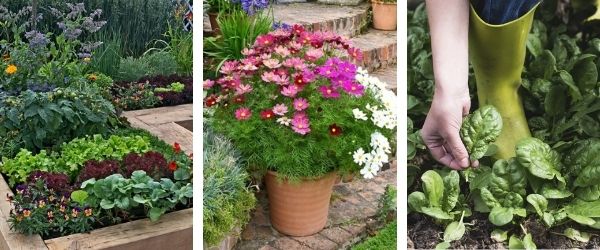Thinking of trying your hand at growing this year but finding yourself asking, “What should a beginner garden look like?” Start off simple with the following plants that are sure to bring you success. Small wins in the garden will help you build confidence and allow you to be more adventurous in coming seasons! Here are our recommendations for a beginner gardener to plant in spring.
Flower Gardening for Beginners – Top 5 Recommendations

Sweet Pea Flowers
Sweet pea flowers are one of the earliest seeds you can start in the spring and, in warmer climates, can even be planted in the winter. These do best when soaked for 24 hours before planting and then direct sown in the garden. Climbing sweet pea varieties add visual interest to the garden and are great for fence lines as they require a trellis for climbing. Dwarf varieties work well in containers and along borders.
Cosmos Flowers
Cosmos produce daisy-like blooms that come in a range of colors for the beginner’s garden. They make excellent cut flowers and are the gift that keeps on giving. They are best directly sown in the garden and are prolific and long-lasting. Cosmos do well in beds and containers and are low maintenance once established. Some varieties can grow up to six feet tall!
Calendula Flowers
Calendula flowers are notoriously easy-to-grow annuals, boasting bright shades of gold and orange. Most varieties make excellent fragrant cut flowers and plantings last from spring through the fall if cut back/dead-headed regularly. They can be started from seed indoors or directly sown in the garden. Calendula is also edible and has medicinal properties! Give a bright flare to meals by using calendula petals as a garnish or in salads or add flower heads to a bath to relieve pain and inflammation.
Zinnia Flowers
If there is one word to describe zinnias it is “dependable.” A prolific cut flower, zinnas’ multi-layered petals bring all shapes, colors, and sizes to the garden. Zinnias are cold sensitive and do best when directly sown one to two weeks after the risk of frost has passed. Try incorporating them into your vegetable garden to attract beneficial insects and deter pests that can wreak havoc on certain crops.
Phlox Flowers
Phlox are low-maintenance flowers with a sweet fragrance that attract butterflies and hummingbirds to the beginner’s flower garden. This upright annual can be directly sown as soon as soil can be worked in early spring. Phlox require regular watering right after planting but are relatively drought-tolerant once established. They make excellent cut flowers that bloom mid-summer through early fall.
Vegetable Gardening for Beginners—Top 5 Recommendations

Radishes
Radishes are the quintessential crop for beginners. They come in a wide variety of colors and shapes and are ready to harvest as soon as a month from seeding! Great for kiddos or beginners who need to build confidence by seeing quick results. Radishes prefer cooler temperatures and do best in the spring and fall. Direct seed them in the garden as soon as soil can be worked in the spring or once temperatures have cooled in the early fall.
Kale
Kale is a dependable staple crop for newbies. Seed kale directly into the garden as soon as soil can be worked in the spring or start them indoors about four weeks before planting outside. Kale can be grown as large plants that will produce throughout the season or as baby leaves that are more tender and suitable for salads.
Beets
Beets are an easy crop to grow and pack a nutritious punch. Direct seed as soon as soil can be worked in early spring for an early to mid-summer root harvest; cook the greens for an iron-rich addition to your plate! Beets require consistent moisture during germination but do well with infrequent watering once established. Thin to two to three inches apart once plants are established to encourage larger beetroot growth.
Swiss Chard
Swiss Chard is a cold-hardy green that adds a pop of color to any vegetable garden (consider adding varieties such as Pink Lipstick or Rainbow of Lights as edibles to ornamental gardens as well!) These can be direct sown as soon as soil can be worked in the spring or grown as seedlings indoors and transplanted outside. Plant seeds close together for baby leaf chard or 8-12 inches apart for larger leaf harvests that will last through the entire growing season!
Spinach
Spinach is the winter wonder vegetable. It does great in cold temperatures and is a perfect candidate for beginners looking to get their vegetable garden going early. Like many other greens, spinach can be grown as a cut-and-come-again baby leaf crop for salads or as larger leaves for cooking. Spinach is particularly sweet during colder months as it pulls sugars into its leaves to protect them from the cold. A must-have for the beginning grower!
One of the most fun aspects of growing a beginner garden is deciding where to grow it. Most of the flowers and vegetables featured here can be grown in small spaces—a container of flowers, a small patch of earth near your home, or even a raised garden bed. Get creative with where to display the fruits of your labor, but make sure it’s pretty accessible. You’ll want cut flowers and fresh veggies at arm’s reach! Happy gardening.

Beginner gardens can be anywhere you like!